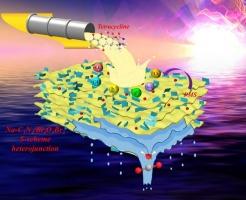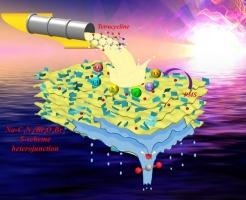Design and mechanistic insight into a Na-C3N4/Bi4O5Br2 S-scheme heterojunction for efficient antibiotic degradation via low concentration peroxymonosulfate activation
IF 6.9
2区 材料科学
Q2 CHEMISTRY, PHYSICAL
引用次数: 0
Abstract
Advances in medical biotechnology have driven the widespread use of antibiotics, leading to their environmental persistence and associated threats to human health. In this work, a Na-modified S-scheme heterojunction Na-C3N4/Bi4O5Br2 was fabricated for photocatalytic activation of PMS to degrade tetracycline (TC). The Na ions are embedded into the heptazine ring of C3N4, which alters the symmetrical structure of C3N4. Importantly, Na-C3N4/Bi4O5Br2 activated a low PMS dosage (5 mg) to generate reactive oxygen species, achieving rapid tetracycline degradation (91 % in 10 min). This superior performance stems from the synergistic effects of efficient charge separation and the strong redox capacity of the heterojunction. In-situ XPS analysis revealed the electron transfer pathway within the Na-C3N4/Bi4O5Br2 composite under both dark and illuminated conditions. Combined with DFT calculations, these results support an S-scheme mechanism for PMS activation in TC degradation. Upon light irradiation, electrons in the CB of Na-C3N4 preferentially migrate to the VB of Bi4O5Br2, while the remaining electrons in the CB of Bi4O5Br2 and holes in the VB of Na-C3N4 react with OH−, O2, and PMS to generate reactive species. This study proposed a reasonable design for an ionic-doped S-scheme heterojunction used for degradation of organic wastewater through photocatalysis and advanced oxidation technology.


Na-C3N4/Bi4O5Br2 S-scheme异质结通过低浓度过氧单硫酸盐活化高效降解抗生素的设计和机理研究
医学生物技术的进步推动了抗生素的广泛使用,导致抗生素在环境中持续存在,并对人类健康构成相关威胁。本文制备了一种na修饰的S-scheme异质结Na-C3N4/Bi4O5Br2,用于光催化PMS降解四环素(TC)。钠离子嵌入到C3N4的七嗪环中,改变了C3N4的对称结构。重要的是,Na-C3N4/Bi4O5Br2激活低PMS剂量(5 mg)产生活性氧,实现快速四环素降解(10分钟91%)。这种优异的性能源于高效电荷分离的协同效应和异质结强大的氧化还原能力。原位XPS分析揭示了Na-C3N4/Bi4O5Br2复合材料在黑暗和光照条件下的电子转移途径。结合DFT计算,这些结果支持PMS在TC降解中激活的S-scheme机制。在光照射下,Na-C3N4的CB中的电子优先迁移到Bi4O5Br2的VB中,而Bi4O5Br2的CB中剩余的电子和Na-C3N4的VB中的空穴与OH−、O2和PMS反应生成活性物质。本研究提出了一种合理设计的离子掺杂s型异质结,用于光催化和高级氧化技术降解有机废水。
本文章由计算机程序翻译,如有差异,请以英文原文为准。
求助全文
约1分钟内获得全文
求助全文
来源期刊

Applied Surface Science
工程技术-材料科学:膜
CiteScore
12.50
自引率
7.50%
发文量
3393
审稿时长
67 days
期刊介绍:
Applied Surface Science covers topics contributing to a better understanding of surfaces, interfaces, nanostructures and their applications. The journal is concerned with scientific research on the atomic and molecular level of material properties determined with specific surface analytical techniques and/or computational methods, as well as the processing of such structures.
 求助内容:
求助内容: 应助结果提醒方式:
应助结果提醒方式:


